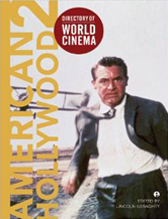
REVIEW: Daft Punk’s Electroma
Ostensibly, Daft Punk’s Electroma traces two robots’ seemingly futile journey to become ‘human’. However, while the narrative suggests similarities with popular science-fiction films such as Blade Runner, or Bicentennial Man, Electroma is not easily identifiable as a genre film. Directors Thomas Bangalter and Guy-Manuel de Homen-Christo may be better known for their sounds (as French electronic-house duo ‘Daft Punk’) than for their filmmaking, but Electroma doesn’t fit comfortably in the musical-film category either. This is certainly no extended video clip or album tie-in. In fact, unlike their previous collaboration, Interstella 5555: The 5tory of the 5ecret 5tar 5ystem, Electroma is noteworthy for its absence of Daft Punk recordings.
 The decision to produce a film that bears the group’s name in its title while doing away with their music is a bold decision, but one that seems to have had a liberating effect. Rather than organising the film’s imagery solely around its soundscape, Bangalter and Homen-Christo’s use of music throughout Electroma is highly restrained; silence is the film’s predominant motif. In the absence of dialogue, it is the music with its distinctive 1970s tones (Todd Rundgren, Curtis Mayfield and Brian Eno) that gives voice to the robot protagonists, shifting between lyrics such as “I am scared”, and “I want to be a man”.
The decision to produce a film that bears the group’s name in its title while doing away with their music is a bold decision, but one that seems to have had a liberating effect. Rather than organising the film’s imagery solely around its soundscape, Bangalter and Homen-Christo’s use of music throughout Electroma is highly restrained; silence is the film’s predominant motif. In the absence of dialogue, it is the music with its distinctive 1970s tones (Todd Rundgren, Curtis Mayfield and Brian Eno) that gives voice to the robot protagonists, shifting between lyrics such as “I am scared”, and “I want to be a man”.
Electroma’s 1970s influences are also evident in the film’s stylistic features; employing jump cuts, long single takes, and a deliberately contemplative pace. Such formal techniques are perhaps an inevitable consequence of the references that it makes to the earlier decade’s films, alluding at various points to THX-1138, Zabriskie Point, Westworld, Invasion of the Body Snatchers, and even in a curious way to David Lynch’s The Elephant Man. For me though, the film seems to resonate most strongly with Terrence Malick’s 1973 film Badlands, only in Electroma the existentialist theme is refracted through a post-human lens.
In the opening sequence the robots board a black sedan and take off along a highway through the desert, their Californian license plate proclaiming, “HUMAN”. At first this reference at first seems like an ironic comment, but as the narrative goes on it signals out the object of desire for these cybernetic men. In a following scene the robots attempt to have human features grafted onto their helmets through a surgical procedure – the absurdity of the attempt borders on the comical but instead Bangalter and Homen-Christo conjure up a strangely affective pathos for these two nameless creations.
 As the robots wander off into the desert in the film’s final stages, Electroma’s existential poetry comes to the fore. Cutting between various still shots of dunes and ridges, the sequence concludes, almost imperceptibly, with a forward tracking shot between a woman’s thighs. The deft switch from a barren landscape to an image with metaphoric associations of life and birth retraces the robots’ desire, but here it’s an impossible object, an oasis that can never be realised. The film’s final imagery, at once beautiful and sombre is equally haunting, as Jackson C. Frank’s lyrics cry out, “I want to be alone…face the grave that I have grown”. Electroma is a compelling piece of cinema.
As the robots wander off into the desert in the film’s final stages, Electroma’s existential poetry comes to the fore. Cutting between various still shots of dunes and ridges, the sequence concludes, almost imperceptibly, with a forward tracking shot between a woman’s thighs. The deft switch from a barren landscape to an image with metaphoric associations of life and birth retraces the robots’ desire, but here it’s an impossible object, an oasis that can never be realised. The film’s final imagery, at once beautiful and sombre is equally haunting, as Jackson C. Frank’s lyrics cry out, “I want to be alone…face the grave that I have grown”. Electroma is a compelling piece of cinema.





RSS feed for comments on this post. TrackBack URI